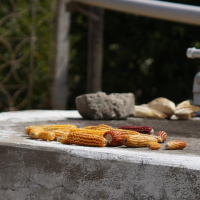
Read the full review here
Photo by Washington Bruno Rodrigues Cavalcante on Unsplash
Reducing aflatoxin intake with agricultural and nutritional education to improve growth of infants and children in low‐ and middle‐income countries
Review question
Does providing agricultural and nutritional education about how to reduce the intake of aflatoxins (from contaminated food crops) in households and communities in low and middle‐income countries (LMICs) improve the growth of infants and children compared to usual or no education?
Background
Aflatoxins are toxins produced by moulds that contaminate food crops. Maize and groundnuts are the major dietary sources of aflatoxins, as they are eaten in large amounts by many people living in LMICs. Some research from LMICs suggests that there may be a link between aflatoxin intake during pregnancy and early childhood, and growth in infants and young children.
Study Characteristics
We included three trials, conducted in pregnant and breastfeeding women (1168 mother‐child pairs), women of childbearing age (N = 231), and infants and young children (< 59 months old), from rural, subsistence maize‐farming communities in Kenya, Tanzania, and Zimbabwe. One trial in Tanzania, at unclear risk of bias overall, provided data for this review, since one trial did not report any outcomes relevant to this review, and we were unable to obtain unpublished growth data for another, even after contacting the study authors.
The trial, conducted in breastfeeding women and their babies, studied the effects of agricultural education (demonstrations to change farmers' practices after harvesting their maize crops to reduce aflatoxins (for example, by handsorting and de‐hulling the maize, using drying sheets and insecticides) on the babies' weight, standardised for age (weight‐for‐age z‐score (WAZ)), after six months (the z‐score measures the difference between these babies and the median of a population of similar babies). Farmers in the control group received routine services from agriculture extension workers.
Key results
Very low‐certainty evidence from one trial suggested that the WAZ of 128 children from farmers' households who received agricultural education may improve by a z‐score of 0.57, compared to 121 children from households where farmers only received routine services. This means that a baby girl in the intervention group, with a healthy weight, would gain about 450 to 690 grams more weight between three to nine months, compared to a baby girl in the control group. This is a meaningful difference.
Another way of measuring the effect is to compare the proportion of underweight infants (WAZ ≥ 2 standard deviations below the reference median value) per group, after the intervention. In this case, agricultural education may reduce the proportion of underweight children, on average, by 6.7% (very low‐certainty evidence), compared to routine services.
None of the included studies addressed the effects of nutritional education on length of height, or on unintended effects of agricultural or nutritional education.
Evidence about the effects on child growth of agricultural or nutritional education interventions that reduce aflatoxin exposure in LMICs was very limited. Data from one trial suggested that agricultural education, aimed at changing farmers' post‐harvest practices to reduce aflatoxin exposure, may result in the babies' increased weight‐for‐age, compared to usual or no education.
The literature was searched to August 2019.
Quality of the evidence
We have very little confidence in the results. The true effect may be substantially different.
Read the full review here
